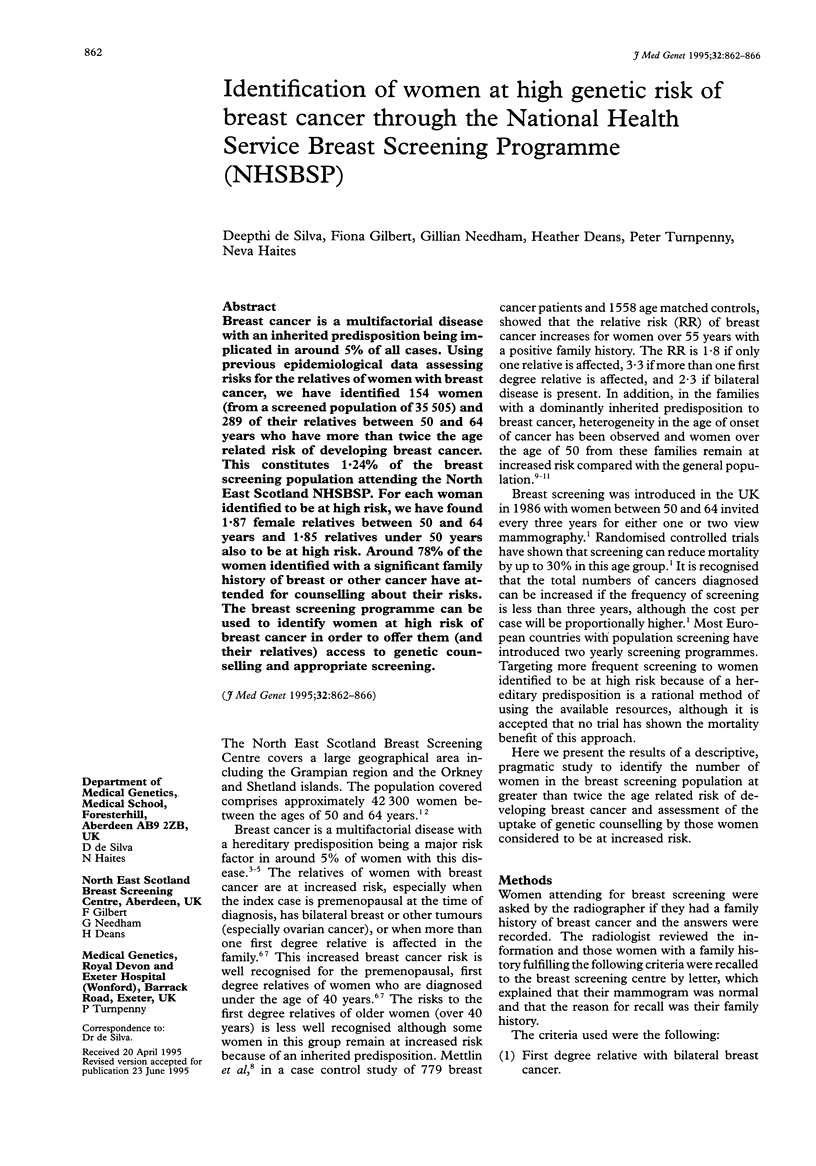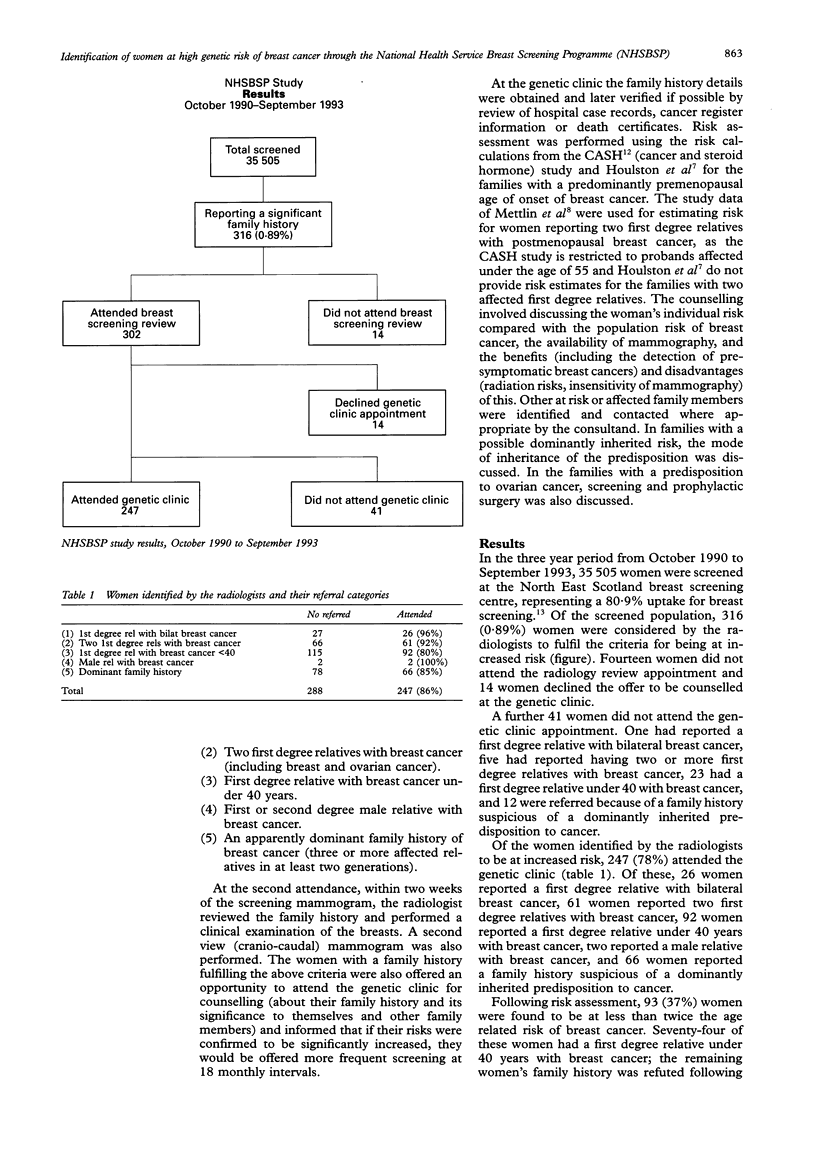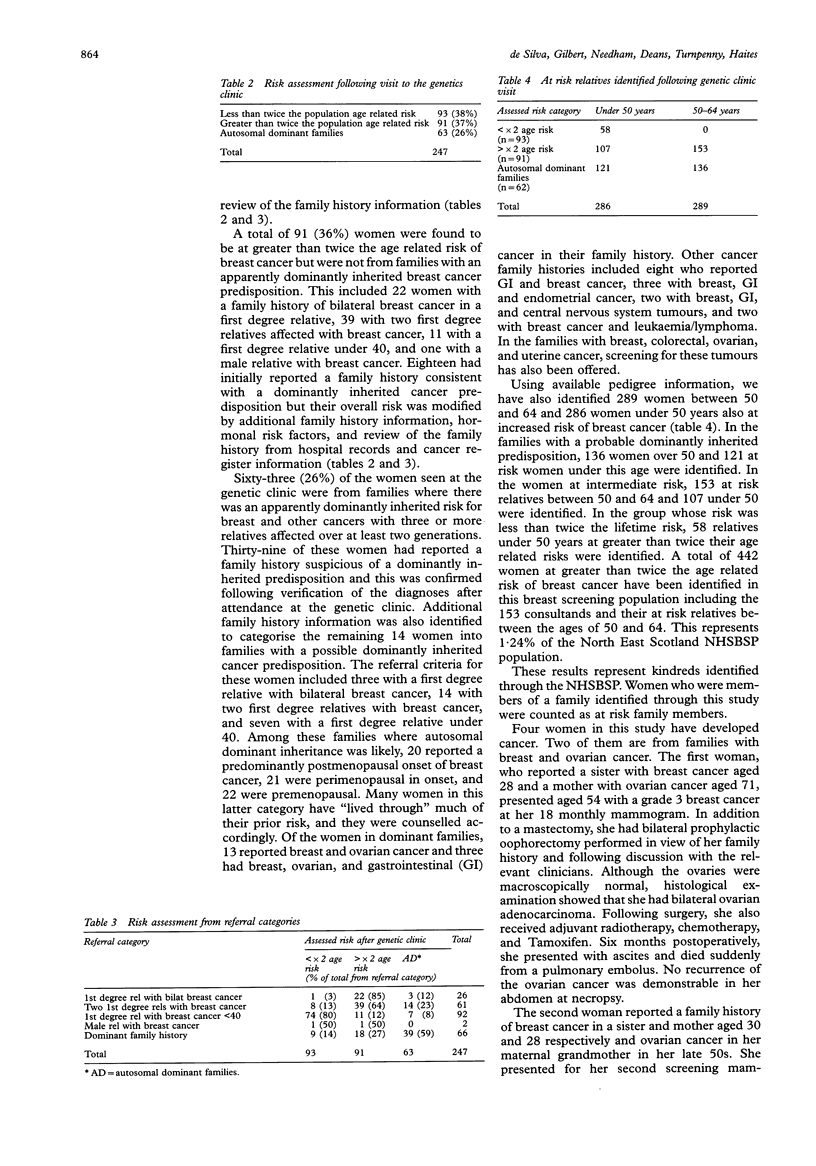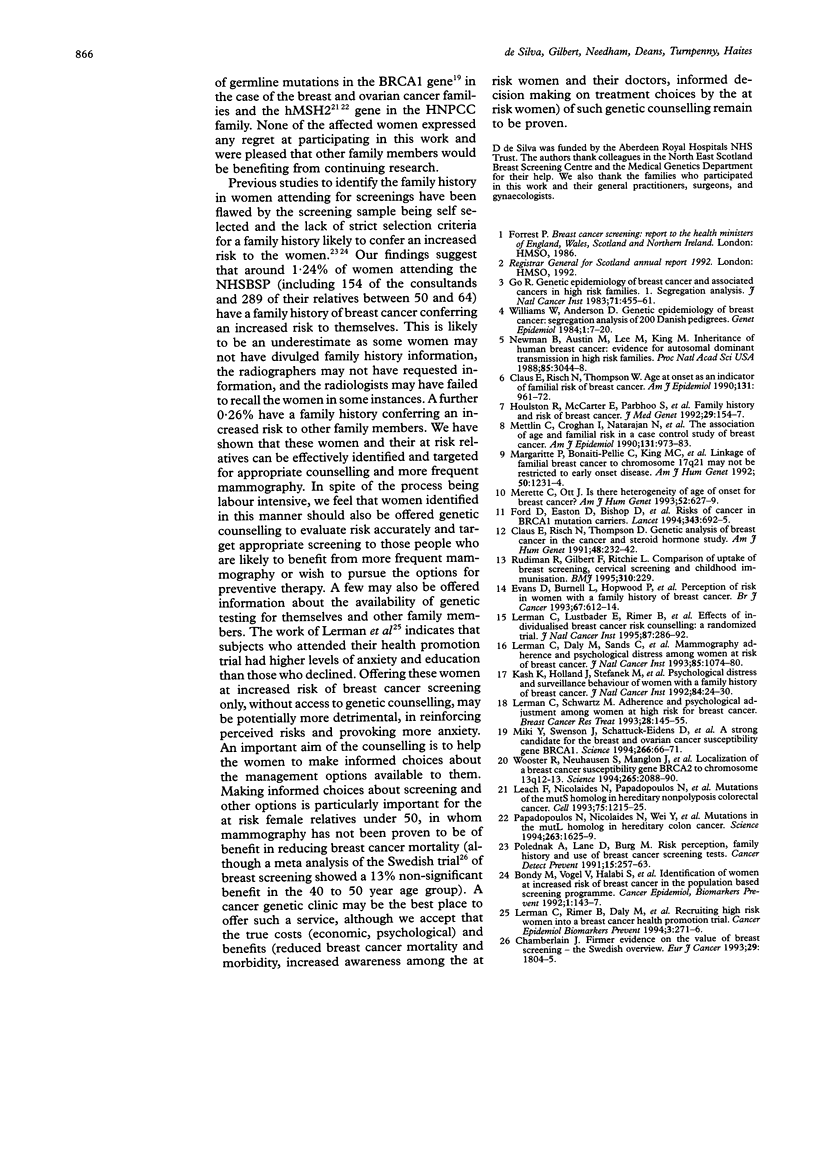Abstract
Breast cancer is a multifactorial disease with an inherited predisposition being implicated in around 5% of all cases. Using previous epidemiological data assessing risks for the relatives of women with breast cancer, we have identified 154 women (from a screened population of 35,505) and 289 of their relatives between 50 and 64 years who have more than twice the age related risk of developing breast cancer. This constitutes 1.24% of the breast screening population attending the North East Scotland NHSBSP. For each woman identified to be at high risk, we have found 1.87 female relatives between 50 and 64 years and 1.85 relatives under 50 years also to be at high risk. Around 78% of the women identified with a significant family history of breast or other cancer have attended for counselling about their risks. The breast screening programme can be used to identify women at high risk of breast cancer in order to offer them (and their relatives) access to genetic counselling and appropriate screening.
Full text
PDF




Selected References
These references are in PubMed. This may not be the complete list of references from this article.
- Bondy M. L., Vogel V. G., Halabi S., Lustbader E. D. Identification of women at increased risk for breast cancer in a population-based screening program. Cancer Epidemiol Biomarkers Prev. 1992 Jan-Feb;1(2):143–147. [PubMed] [Google Scholar]
- Chamberlain J. Firmer evidence on the value of breast screening--the Swedish overview. Eur J Cancer. 1993;29A(13):1804–1805. doi: 10.1016/0959-8049(93)90524-j. [DOI] [PubMed] [Google Scholar]
- Claus E. B., Risch N. J., Thompson W. D. Age at onset as an indicator of familial risk of breast cancer. Am J Epidemiol. 1990 Jun;131(6):961–972. doi: 10.1093/oxfordjournals.aje.a115616. [DOI] [PubMed] [Google Scholar]
- Claus E. B., Risch N., Thompson W. D. Genetic analysis of breast cancer in the cancer and steroid hormone study. Am J Hum Genet. 1991 Feb;48(2):232–242. [PMC free article] [PubMed] [Google Scholar]
- Evans D. G., Burnell L. D., Hopwood P., Howell A. Perception of risk in women with a family history of breast cancer. Br J Cancer. 1993 Mar;67(3):612–614. doi: 10.1038/bjc.1993.112. [DOI] [PMC free article] [PubMed] [Google Scholar]
- Ford D., Easton D. F., Bishop D. T., Narod S. A., Goldgar D. E. Risks of cancer in BRCA1-mutation carriers. Breast Cancer Linkage Consortium. Lancet. 1994 Mar 19;343(8899):692–695. doi: 10.1016/s0140-6736(94)91578-4. [DOI] [PubMed] [Google Scholar]
- Go R. C., King M. C., Bailey-Wilson J., Elston R. C., Lynch H. T. Genetic epidemiology of breast cancer and associated cancers in high-risk families. I. Segregation analysis. J Natl Cancer Inst. 1983 Sep;71(3):455–461. [PubMed] [Google Scholar]
- Houlston R. S., McCarter E., Parbhoo S., Scurr J. H., Slack J. Family history and risk of breast cancer. J Med Genet. 1992 Mar;29(3):154–157. doi: 10.1136/jmg.29.3.154. [DOI] [PMC free article] [PubMed] [Google Scholar]
- Kash K. M., Holland J. C., Halper M. S., Miller D. G. Psychological distress and surveillance behaviors of women with a family history of breast cancer. J Natl Cancer Inst. 1992 Jan 1;84(1):24–30. doi: 10.1093/jnci/84.1.24. [DOI] [PubMed] [Google Scholar]
- Leach F. S., Nicolaides N. C., Papadopoulos N., Liu B., Jen J., Parsons R., Peltomäki P., Sistonen P., Aaltonen L. A., Nyström-Lahti M. Mutations of a mutS homolog in hereditary nonpolyposis colorectal cancer. Cell. 1993 Dec 17;75(6):1215–1225. doi: 10.1016/0092-8674(93)90330-s. [DOI] [PubMed] [Google Scholar]
- Lerman C., Daly M., Sands C., Balshem A., Lustbader E., Heggan T., Goldstein L., James J., Engstrom P. Mammography adherence and psychological distress among women at risk for breast cancer. J Natl Cancer Inst. 1993 Jul 7;85(13):1074–1080. doi: 10.1093/jnci/85.13.1074. [DOI] [PubMed] [Google Scholar]
- Lerman C., Lustbader E., Rimer B., Daly M., Miller S., Sands C., Balshem A. Effects of individualized breast cancer risk counseling: a randomized trial. J Natl Cancer Inst. 1995 Feb 15;87(4):286–292. doi: 10.1093/jnci/87.4.286. [DOI] [PubMed] [Google Scholar]
- Lerman C., Rimer B. K., Daly M., Lustbader E., Sands C., Balshem A., Masny A., Engstrom P. Recruiting high risk women into a breast cancer health promotion trial. Cancer Epidemiol Biomarkers Prev. 1994 Apr-May;3(3):271–276. [PubMed] [Google Scholar]
- Lerman C., Schwartz M. Adherence and psychological adjustment among women at high risk for breast cancer. Breast Cancer Res Treat. 1993 Nov;28(2):145–155. doi: 10.1007/BF00666427. [DOI] [PubMed] [Google Scholar]
- Margaritte P., Bonaiti-Pellie C., King M. C., Clerget-Darpoux F. Linkage of familial breast cancer to chromosome 17q21 may not be restricted to early-onset disease. Am J Hum Genet. 1992 Jun;50(6):1231–1234. [PMC free article] [PubMed] [Google Scholar]
- Mettlin C., Croghan I., Natarajan N., Lane W. The association of age and familial risk in a case-control study of breast cancer. Am J Epidemiol. 1990 Jun;131(6):973–983. doi: 10.1093/oxfordjournals.aje.a115617. [DOI] [PubMed] [Google Scholar]
- Miki Y., Swensen J., Shattuck-Eidens D., Futreal P. A., Harshman K., Tavtigian S., Liu Q., Cochran C., Bennett L. M., Ding W. A strong candidate for the breast and ovarian cancer susceptibility gene BRCA1. Science. 1994 Oct 7;266(5182):66–71. doi: 10.1126/science.7545954. [DOI] [PubMed] [Google Scholar]
- Ott J., Mérette C. Is there heterogeneity of age at onset for breast cancer? Am J Hum Genet. 1993 Mar;52(3):627–630. [PMC free article] [PubMed] [Google Scholar]
- Papadopoulos N., Nicolaides N. C., Wei Y. F., Ruben S. M., Carter K. C., Rosen C. A., Haseltine W. A., Fleischmann R. D., Fraser C. M., Adams M. D. Mutation of a mutL homolog in hereditary colon cancer. Science. 1994 Mar 18;263(5153):1625–1629. doi: 10.1126/science.8128251. [DOI] [PubMed] [Google Scholar]
- Polednak A. P., Lane D. S., Burg M. A. Risk perception, family history, and use of breast cancer screening tests. Cancer Detect Prev. 1991;15(4):257–263. [PubMed] [Google Scholar]
- Rudiman R., Gilbert F. J., Ritchie L. D. Comparison of uptake of breast screening, cervical screening, and childhood immunisation. BMJ. 1995 Jan 28;310(6974):229–229. doi: 10.1136/bmj.310.6974.229. [DOI] [PMC free article] [PubMed] [Google Scholar]
- Williams W. R., Anderson D. E. Genetic epidemiology of breast cancer: segregation analysis of 200 Danish pedigrees. Genet Epidemiol. 1984;1(1):7–20. doi: 10.1002/gepi.1370010104. [DOI] [PubMed] [Google Scholar]
- Wooster R., Neuhausen S. L., Mangion J., Quirk Y., Ford D., Collins N., Nguyen K., Seal S., Tran T., Averill D. Localization of a breast cancer susceptibility gene, BRCA2, to chromosome 13q12-13. Science. 1994 Sep 30;265(5181):2088–2090. doi: 10.1126/science.8091231. [DOI] [PubMed] [Google Scholar]


